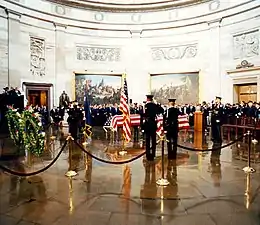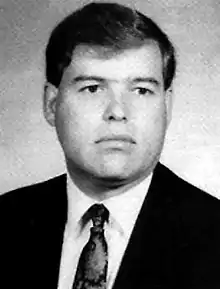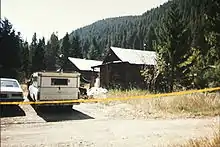1998 United States Capitol shooting
The 1998 United States Capitol shooting was an attack on July 24, 1998, which led to the deaths of two United States Capitol Police officers. Officer Jacob Chestnut and Detective John Gibson were killed when Russell Eugene Weston Jr., entered the Capitol and opened fire.[1] Chestnut was killed instantly and Gibson died during surgery at George Washington University Hospital.[2] Weston's exact motives are unknown, but he had expressed a strong distrust of the federal government of the United States.[3] Weston was later charged on July 26 for the murder of two U.S. Capitol Police officers during the shooting rampage.[4] As of July 2018,[5] Weston, diagnosed with paranoid schizophrenia, remained in a mental institution.[6][7]
| 1998 United States Capitol shooting | |
|---|---|
| Location | Washington, D.C. |
| Date | July 24, 1998 3:40 p.m. – 3:45 p.m. (UTC-4) |
| Target | United States Capitol |
Attack type | Shooting |
| Weapons | .38 caliber Smith & Wesson revolver |
| Deaths | 2 |
| Injured | 3 (including the perpetrator) |
| Perpetrator | Russell Eugene Weston Jr. |
Shooting
On the day of the shooting, Officer Chestnut and an unarmed, civilian security aide were assigned to operate the X-ray machine and magnetometer at the Document Door entrance located on the East Front of the Capitol, which was open only to Members of Congress and their staff. Detective Gibson was assigned to the dignitary protection detail of then House Majority Whip Tom DeLay (R-TX) and was in his suite of offices near this door. Weston, armed with a .38 caliber Smith & Wesson six-shot revolver, entered the Document Door at 3:40 p.m. At the same time, Officer Chestnut was providing directions to a tourist and his son. Weston walked through the metal detector, causing the alarm to go off. Chestnut requested he go back through the detector.[8] Weston suddenly produced the gun and without warning, shot Chestnut in the back of the head at point-blank range. At this time, Officer Douglas McMillan, normally working outside the Capitol, was nearby retrieving keys to get a wheelchair for a tourist. As Weston shot Officer Chestnut, Officer McMillan immediately returned fire, causing Weston to shoot toward McMillan, wounding him. Weston then ran away from McMillan, turning into the first nearby open door that he found. McMillan was unable to successfully hit Weston due to the many civilians in the immediate area. According to witnesses, Weston turned down a short corridor and pushed through a door which led to a group of offices used by senior Republican representatives including then Majority Whip Tom DeLay and Representative Dennis Hastert, future Speaker of the House and a close protégé of then Speaker Newt Gingrich.[9]
Upon hearing the gunfire, Detective Gibson, who was in plainclothes, told the office staff to hide under their desks. Within seconds, Gibson was shot after the suspect entered DeLay's office. Despite being mortally wounded, Detective Gibson was able to return fire, and wound the suspect hitting him with 4 rounds, severely wounding him and causing him to be apprehended in that office by two other officers.[10] Angela Dickerson, a female tourist, was grazed by shrapnel on her face and shoulder from a marble wall, as Officer McMillan's rounds impacted on the wall while he was attempting to hit the fleeing Weston.[11] She was treated for her injuries and released.[12] Senator Bill Frist, a heart surgeon who had been presiding on the Senate floor just before the shooting, resuscitated the gunman and accompanied him to D.C. General Hospital.[1]
After the shooting

Officers Chestnut and Gibson were the two people killed in the attack. Following the shooting, both officers received the tribute of lying in honor in the United States Capitol rotunda. They were the first police officers, and Chestnut was the first male African American, to receive the honor.[13]
In 1999, Weston, a man with schizophrenia who stopped taking his medication, was found incompetent to stand trial due to mental illness.[14] A judge of the United States District Court for the District of Columbia ordered that he be treated with antipsychotic medication without his consent in 2001, and the United States Court of Appeals for the District of Columbia Circuit upheld the decision.[15] In 2004, the court determined that Weston still was not competent to be tried, despite ongoing treatment, and suspended but did not dismiss the criminal charges against him. Weston was known to the United States Secret Service prior to the incident as a person who had threatened the President of the United States.[7]
The shooting led to the creation of the United States Capitol Police Memorial Fund, a nonprofit organization managed by the Capitol Police Board which provides funds for the families of Chestnut and Gibson.[16] In November 2005, the fund was expanded to include the family of Sgt. Christopher Eney, a USCP officer killed during a training accident in 1984.[17] The shooting was cited as one reason for the development of the Capitol Visitors Center. The legislation authorizing the construction of the facility was introduced by Washington, D.C. Delegate Eleanor Holmes Norton and was entitled the Jacob Joseph Chestnut–John Michael Gibson United States Capitol Visitor Center Act of 1998.[18][19] The door where Weston entered was renamed in honor of the two officers, from the Document Door to the Chestnut-Gibson Memorial Door.[20]
On March 6, 2008, Weston filed a motion requesting a hearing on his mental status. The hearing was held on May 6 with Weston appearing via teleconference from the Federal Medical Center, Butner with his public defender Jane Pierce and two witnesses he selected, a psychologist and vocational rehabilitation specialist.[6] Federal judge Earl Britt denied Weston's request to be released from the federal facility, arguing that he failed to present enough evidence that he no longer needed to be committed. During the hearing defense psychologist Holly Rogers stated that, "sometimes there are individuals who simply do not respond to medication", implying that Weston was not ready for release. Had Weston been released from the facility, it would have made it possible for him to be taken to Washington, D.C. to stand trial for the murders of Gibson and Chestnut.[12]
Officers


Officer Jacob Joseph Chestnut (April 28, 1940 – July 24, 1998) was the first African American to lie in honor at the Capitol. Chestnut, a retired United States Air Force veteran, is buried in Arlington National Cemetery.[21] His funeral included a speech by President Bill Clinton and a fly-over by military jets in a missing man formation. A United States Post Office located in Fort Washington, Maryland, has been renamed in his and Detective John Gibson's honor.
Detective John Michael Gibson (March 29, 1956 – July 24, 1998) was a United States Capitol Police officer assigned to the dignitary protection detail of Congressman Tom DeLay. He is buried in Arlington National Cemetery[22] after lying in honor with Chestnut in the Capitol rotunda. Detective Gibson had served with the agency for 18 years. He was a native of Massachusetts who married the niece of Representative Joe Moakley, Democrat of Massachusetts.[23] He had three children, a 17-year-old daughter and two boys, ages 15 and 14. Growing up in New England, Det. Gibson was a lifelong Boston Red Sox fan, and on August 11, 1998, his beloved team had a moment of silence in his honor prior to a game with the Kansas City Royals.
Suspect
Russell Eugene Weston, Jr. (born December 28, 1956), also known as Rusty, grew up in Valmeyer, Illinois. Weston attended Valmeyer High School, the only high school in a town of 900 people. Shortly after graduating from high school in 1974, Weston moved to Rimini, Montana, rarely returning to Valmeyer. The only attempt his high school classmates made at inviting him to a class reunion was returned with obscenities written across it.[24] Many of Weston's Montana neighbors had disliked him, and often ignored him. They considered him to be unusual, and sometimes eccentric. Weston had once thought that his neighbor was using his television satellite dish to spy on his actions and believed Navy SEALs were hiding in his cornfield.[24]

He was diagnosed with paranoid schizophrenia six years before the shooting and spent fifty-three days in a mental hospital after threatening a Montana resident. He was released after testing as being of no danger to himself or anyone else.[25] Two years before the shooting in July of 1996, Weston bought a new suit and set off on a cross-country trip to visit the headquarters of the Central Intelligence Agency in McLean, Virginia. There, he gave his operative name as "The Moon," and claimed he had important information for the CIA director. Apparently based on nothing more than this he was admitted to the facility, where he was interviewed by an unnamed CIA officer and then sent on his way.[26] It is unknown why Weston, who has no known security credentials nor connection to the intelligence community, was granted access to the agency's high-security headquarters facility.
Eighteen months before the shooting, he moved back to Valmeyer from Montana. Once home, he was known to compulsively hack at trees which filled his back yard following the Mississippi River floods of 1993. There was so much downed timber on his family's homestead that they had to ask him to stop cutting at trees.[25] Two days prior to the Capitol shooting, at his grandmother's insistence to do something about nearby cats which were becoming a nuisance, Weston shot and killed 14 cats with a single-barreled shotgun, leaving several in a bucket and burying the rest.[25]
Following the Capitol shooting, Weston was transferred to a psychiatric center at Butner Federal Correctional Institution in Butner, North Carolina. In an interview with a court-appointed psychiatrist he explained that he stormed the Capitol to prevent the United States from being annihilated by disease and legions of cannibals.[27]
One contentious issue of Weston's incarceration was that of forced medication. He had refused to take any medications voluntarily, so in May 2001, a federal judge authorized doctors to treat Weston involuntarily. A panel from a federal appeals court ruled in July 2001 that Weston could be forced to take the drugs, which he was then forced to do for 120 days.[28] He remains in the civil commitment indefinitely.[29]
See also
References
- "2 dead, 2 hurt in U.S. Capitol shooting". CNN.com. Archived from the original on October 29, 2006. Retrieved January 19, 2007.
- Dwilson, Stephanie Dube (February 28, 2018). "Jacob Chestnut & John Gibson: 5 Fast Facts You Need to Know". Heavy.com. Retrieved August 13, 2020.
- Marion, Nancy E.; Oliver, Willard (2014). Killing Congress: Assassinations, Attempted Assassinations and Other Violence against Members of Congress. Lexington Books. ISBN 978-0-7391-8360-1.
- Thompson, Michael Grunwald; Cheryl W. (July 26, 1998). "Weston Charged with Murder in Rampage". Washington Post. ISSN 0190-8286. Retrieved August 13, 2020.
- Remembering the ’98 Capitol shooting (Photos) WTOP-FM
- Yehle, Emily (May 7, 2008). "Weston unlikely to ever be tried". Roll Call. Washington, D.C.: Roll Call, Inc. pp. 1, 16.
- "Capitol shooting suspect was 'low-level threat' to Clinton". CNN.com. Archived from the original on September 13, 2005. Retrieved January 11, 2007.
- "Gunman Shoots His Way Into Capitol; Two Officers Killed, Suspect Captured". Washingtonpost.com. January 30, 1999. Retrieved January 12, 2007.
- "Attack on Capitol Hill". EmergencyNet News. Archived from the original on December 8, 2006. Retrieved January 11, 2007.
- Clines, Francis X. (July 25, 1998). "Capitol Hill Slayings: The Overview; Gunman Invades Capitol, Killing 2 Guards". Newyorktimes.com. Retrieved January 11, 2007.
- "Horrifying Capitol ordeal began with officer's execution". (July 26, 1998). Milwaukee Journal Sentinel, The.
- Yehle, Emily (April 16, 2008). "Weston Competency Hearing Set". Roll Call. Washington, D.C.: Roll Call, Inc. pp. 1, 18.
- "Authorizing the use of the Rotunda of the Capitol..." United States Senate.
- Frieden, Terry. "Weston found incompetent to stand trial for Capitol shooting". CNN.com. Retrieved January 11, 2007.
- "Capitol Shooter Russell Weston, Three Years Later". New York Press. Archived from the original on November 28, 2006. Retrieved January 11, 2007.
- "U.S. Code Title 2, 1953". Cornell Law School. Retrieved January 17, 2007.
- "Members, Capitol Police Square Off in 2006 "Longest Yard" Flag Football Game". Rep. Rick Renzi (AZ-01). Archived from the original on January 5, 2007. Retrieved January 17, 2007.
- "Jacob Joseph Chestnut–John Michael Gibson United States Capitol Visitor Center Act of 1998 (Introduced in House)". United States House of Representatives. Retrieved January 11, 2007.
- "Attack Stirs Interest in Visitors Center". Washingtonpost.com. January 30, 1999. Retrieved January 11, 2007.
- "To rename the Document Door of the Capitol as the Chestnut-Gibson Memorial Door. (Introduced in Senate)". United States Senate. Retrieved January 18, 2007.
- Burial Detail: Chestnut, Jacob J (section 4, grave 2764-A) – ANC Explorer
- Burial Detail: Gibson, John M (section 28, grave 140) – ANC Explorer
- Schmitt, Eric (July 27, 1998). "Capitol Hill slayings: The Police; Congress to Pay Tribute to Slain Officers". Newyorktimes.com. Retrieved January 17, 2007.
- "Capitol Hill Slayings: The Suspect; Man Hospitalized in '96 for Ominous Letters". Newyorktimes.com. July 26, 1998. Retrieved January 19, 2007.
- "Before the Shootings, a String of Excesses". Washingtonpost.com. January 30, 1999. Retrieved January 11, 2007.
- "A Living Hell or a Life Saved?". Washingtonpost.com. January 23, 2001. Retrieved December 23, 2020.
- "Capitol Shooter's Mind-Set Detailed". Washingtonpost.com. April 23, 1999. Retrieved January 26, 2010.
- "Judge Rules Capitol Gunman Can Be Forced to Take Medicine". Newyorktimes.com. August 3, 2002. Retrieved January 19, 2007.
- "Forcible Medication of Mentally Ill Criminal Defendants: The Case of Russell Eugene Weston, Jr". Stanford Law Review. 54 (4) – via JSTOR.
External links
- Indictment of Russell Eugene Weston, Jr.
- Tributes by members of Congress, C-SPAN
- "From the Shootings to the Investigation", The Washington Post
- Jacob Joseph Chestnut; John Michael Gibson, ArlingtonCemetery•net, an unofficial website
| Honorary titles | ||
|---|---|---|
| Preceded by Claude Pepper |
Persons who have lain in state or honor in the United States Capitol rotunda (John Gibson and Jacob Chestnut) June 28, 1998 |
Succeeded by Ronald Reagan |